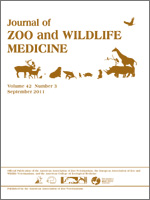A potential cause of pododermatitis (“bumblefoot”) was investigated in captive-reared juvenile black stilts at the Department of Conservation “Kaki Recovery Program” at Twizel, New Zealand. To address the importance of substrate, the development of clinical signs in individuals was compared among aviaries that contained rubber matting and/or salt footbaths, and controls. No effect of either experimental manipulation of the environment was apparent on pododermatitis development. With the substrate appearing not to be an initiating factor, and a previous study that indicated that the birds' diet fulfills the nutritional requirements for rearing black stilts in captivity, results of this study suggest that insufficient space for exercise may instead be the cause.
How to translate text using browser tools
1 September 2011
Pododermatitis in Captive-Reared Black Stilts (Himantopus novaezelandiae)
Elizabeth Chang Reissig,
Daniel M Tompkins,
Richard F Maloney,
Emily Sancha,
David A Wharton
ACCESS THE FULL ARTICLE
Black stilt
captivity
endangered bird
Himantopus novaezelandiae
pododermatitis
recovery program





